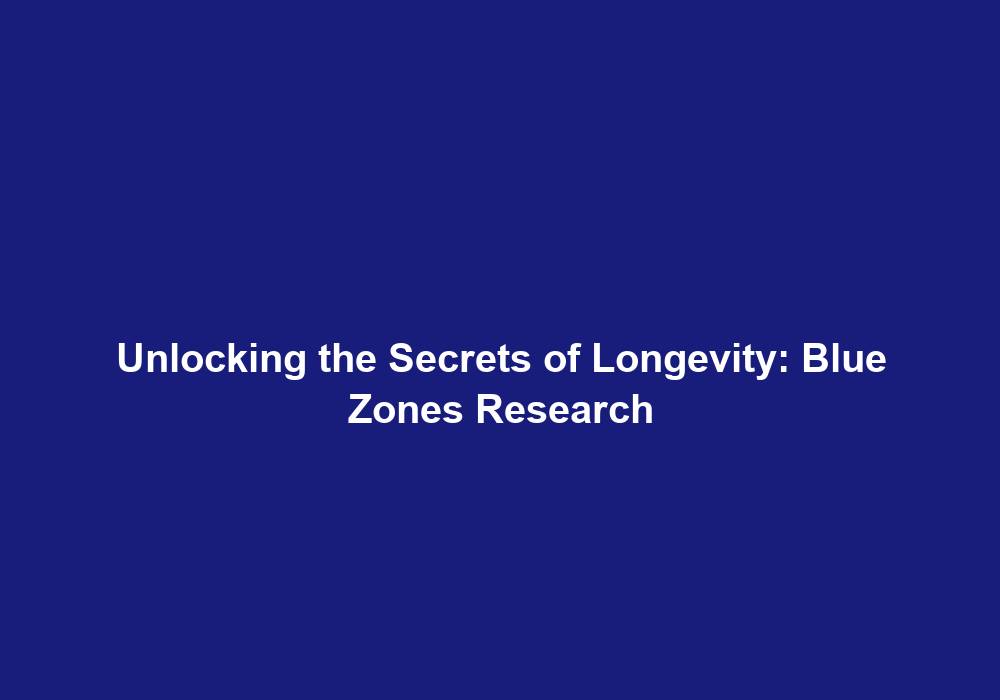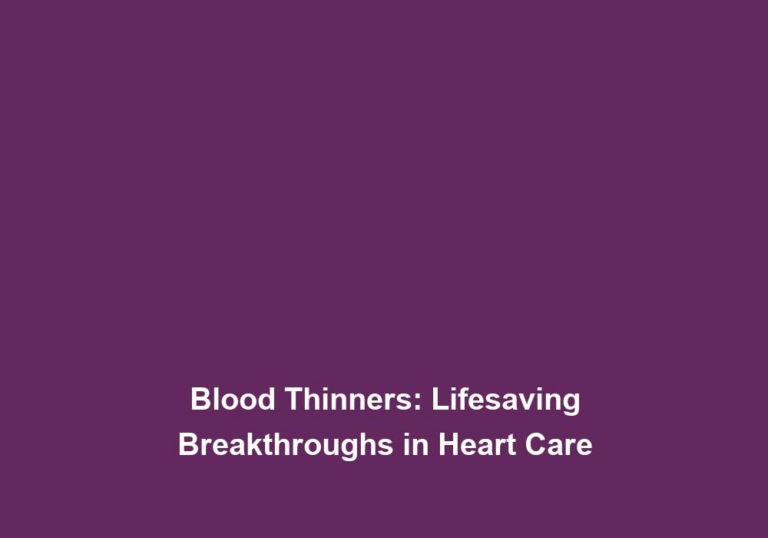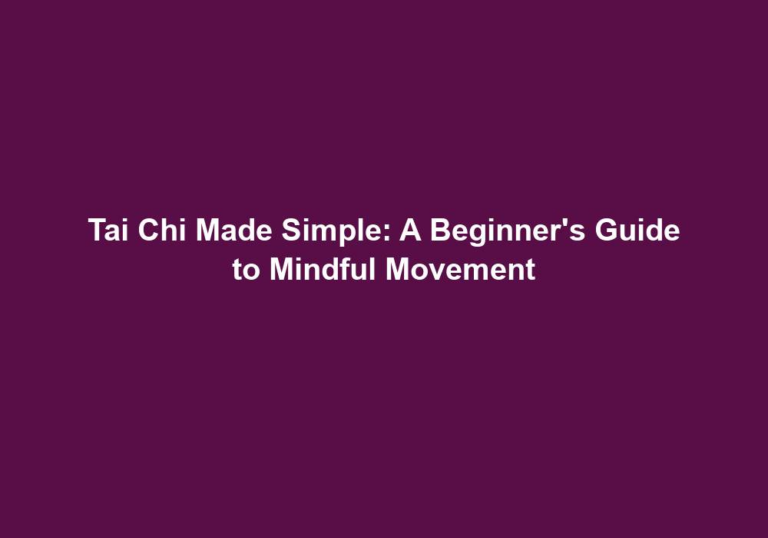Unlocking the Secrets of Longevity: Blue Zones Research
The pursuit of longevity has always been a fascinating subject for humanity. Many people desire to lead long and healthy lives, and one way to uncover the secrets of longevity is through the study of Blue Zones. Blue Zones are regions around the world where people live exceptionally long and healthy lives. These regions have drawn the attention of researchers and sparked curiosity about the lifestyle and habits of their inhabitants. In this article, we will explore the fascinating world of Blue Zones research and delve into the secrets that contribute to longevity.
What are Blue Zones?
Blue Zones are geographic areas that have been identified as having a higher concentration of individuals who live to be over 100 years old. These regions have been extensively studied by researchers, such as National Geographic Fellow Dan Buettner, who coined the term Blue Zones and conducted groundbreaking research on the subject.
Blue Zones have been identified in different parts of the world, including Okinawa, Japan; Sardinia, Italy; Nicoya, Costa Rica; Icaria, Greece; and Loma Linda, California. These regions have diverse cultures and lifestyles, but they share commonalities that contribute to the longevity of their residents.
Blue Zones Research Methodology
To unlock the secrets of longevity, researchers have employed various methodologies in studying Blue Zones. They have conducted extensive interviews, gathered data, and observed the lifestyles and habits of the inhabitants in these regions. By closely examining the commonalities among the Blue Zones, researchers have been able to identify key factors that contribute to longevity.
Researchers have spent years living among the residents of Blue Zones, immersing themselves in their communities, and documenting their daily lives. This ethnographic approach has allowed them to gain a deep understanding of the cultural practices and social dynamics that promote longevity.
Additionally, researchers have collected data on various aspects of the residents’ lives, including their diet, physical activity levels, social connections, stress management techniques, and sense of purpose. This quantitative data, combined with qualitative observations, has provided valuable insights into the factors that contribute to long and healthy lives in Blue Zones.
Key Factors Affecting Longevity
1. Diet
Diet plays a crucial role in the longevity of individuals living in Blue Zones. Although the specific dietary patterns vary among these regions, there are some consistent themes that emerge. Blue Zones residents consume a predominantly plant-based diet, rich in fruits, vegetables, whole grains, legumes, and nuts. These foods are high in nutrients, antioxidants, and fiber, which have been linked to reduced risk of chronic diseases and improved overall health.
In addition to the types of foods consumed, the portion sizes and eating practices in Blue Zones also contribute to longevity. Residents practice moderation and eat until they are 80% full, a practice known as “Hara Hachi Bu” in Okinawa, Japan. This helps prevent overeating and promotes healthy weight management.
2. Physical Activity
Regular physical activity is another essential component of the lifestyle in Blue Zones. Unlike structured exercise programs, physical activity in these regions is a natural part of daily life. People engage in activities such as walking, gardening, and manual labor, which help them maintain an active lifestyle and contribute to their longevity.
Incorporating physical activity into daily routines has several benefits for longevity. It helps maintain a healthy weight, strengthens the cardiovascular system, improves bone density, and enhances overall physical and mental well-being. Additionally, the social aspect of physical activity in Blue Zones, such as walking with friends or participating in community events, further promotes a sense of belonging and strengthens social connections.
3. Social Engagement
Social connections and strong community ties have been found to be significant factors in the longevity of individuals in Blue Zones. Close-knit communities provide emotional support, a sense of belonging, and a purpose in life. Regular social interactions and meaningful relationships have been associated with improved overall well-being and increased lifespan.
Residents of Blue Zones prioritize spending time with family and friends, participating in community activities, and maintaining strong social networks. These social interactions not only provide support during challenging times but also contribute to a positive outlook on life and a sense of fulfillment.
4. Stress Reduction
Effective stress management techniques are prevalent among individuals in Blue Zones. Practices like meditation, napping, and having a strong sense of purpose are common in these regions. By adopting stress-reducing practices, individuals in Blue Zones are able to lead more relaxed and balanced lives, which positively impacts their health and longevity.
Stress has been linked to various health issues, including cardiovascular diseases, obesity, and mental health disorders. In Blue Zones, residents prioritize self-care and engage in activities that promote relaxation and stress reduction. Regular meditation, deep breathing exercises, and taking time for oneself help reduce stress levels and contribute to overall well-being.
5. Sense of Purpose
Having a sense of purpose and finding meaning in life has been identified as a crucial factor in the longevity of individuals. In Blue Zones, people often have a strong sense of purpose, which provides them with a reason to wake up every morning and motivates them to lead fulfilling lives. Having a clear purpose has been associated with lower rates of chronic diseases and increased overall well-being.
Residents of Blue Zones often have a strong connection to their community and actively contribute to society. They engage in activities that align with their values and passions, whether it be through work, volunteering, or pursuing hobbies. This sense of purpose gives them a sense of fulfillment and a reason to live a healthy and meaningful life.
Implementing Blue Zone Practices
While the concept of Blue Zones may seem distant and exotic, there are practical ways to incorporate their principles into our own lives. Here are some suggestions:
- Adopt a plant-based diet by increasing the consumption of fruits, vegetables, whole grains, legumes, and nuts while reducing the intake of processed foods. Explore local markets and try new recipes to make healthy eating enjoyable.
- Incorporate regular physical activity into your daily routine. This can be achieved by walking or biking instead of driving, taking the stairs instead of the elevator, or engaging in activities that you enjoy, such as dancing, swimming, or practicing yoga.
- Foster social connections by spending time with loved ones, joining community groups or clubs, and volunteering. Engage in meaningful conversations, actively listen to others, and make an effort to strengthen your relationships.
- Practice stress management techniques such as meditation, deep breathing exercises, or engaging in hobbies that bring you joy and relaxation. Create a daily routine that includes moments of mindfulness and self-care to reduce stress levels and promote overall well-being.
- Reflect on your life and identify your sense of purpose. Set meaningful goals and work towards them, whether they are related to career, personal growth, or contributing to society. Find activities or projects that bring you fulfillment and align with your values.
By adopting these practices, we can increase our chances of living longer, healthier, and more fulfilling lives.
Conclusion
Unlocking the secrets of longevity is an ongoing pursuit, and Blue Zones research provides valuable insights into the factors that contribute to long and healthy lives. Through studying the dietary patterns, physical activity levels, social engagement, stress reduction techniques, and sense of purpose in Blue Zones, researchers have identified key factors for longevity. By incorporating these practices into our own lives, we can unlock the potential for a longer and more vibrant future. So, let’s embrace the wisdom of the Blue Zones and embark on a journey towards a healthier and happier life.







